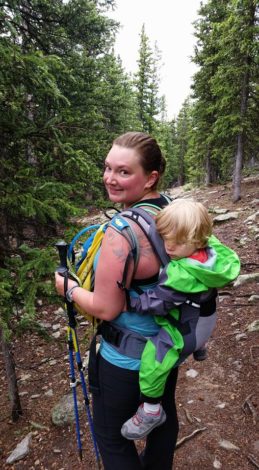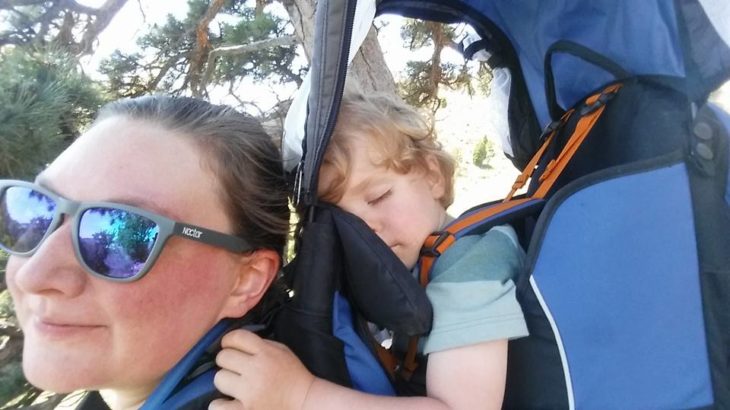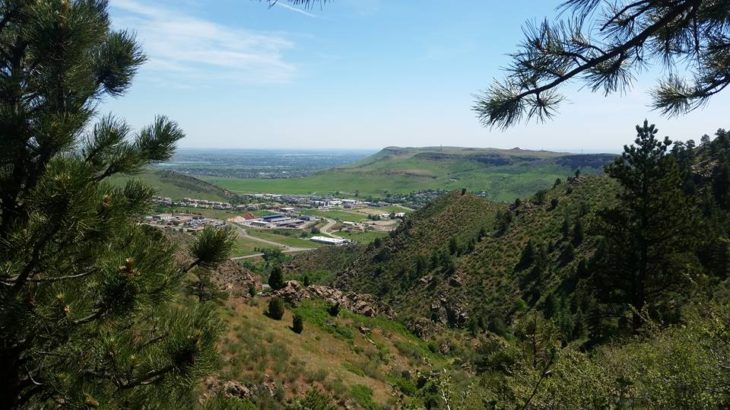When the Heat is Just Too Much
 When we planned the hike the week before, the temperature was forecast to be in the low- to mid-70s. Perfect! But the morning we set out, it was already climbing into the 90s. It was the hottest day so far in the year.
When we planned the hike the week before, the temperature was forecast to be in the low- to mid-70s. Perfect! But the morning we set out, it was already climbing into the 90s. It was the hottest day so far in the year.
I dressed myself and my 2-year-old son lightly. The three-liter Camelbak water bladder was full and in place. The rest was packed lightly: One diaper, a small plastic travel wipes holder and a few wipes, sunscreen, keys, ID and one snack for each of us. I had us fill up on liquids before we even got there. We ate a healthy breakfast.
Once at the trail, we took a slow pace. The first part of this lollipop loop trail was in the full morning sun (we even started out early to beat the worst of the heat!), and my heart was already pumping. It is a challenging trail with a kid on your back, but one that we'd done several times before.
This day, though, I was feeling rough. Pretty early on, I was stopping us for breaks in shady spots to catch our breath and suck down some water. I was wearing a heart rate monitor I'd gotten a few years earlier in an attempt to correctly capture my calorie burn, and I noticed at one point that my heart rate was taking a lot longer than normal to dip back down during our rests. My legs felt heavy, and I moved slower than ever.
Finally, we stopped under the shade of some trees for a snack. This time, even in 10-15 minutes seated and without my kid on my back, my heart rate never got below 130. This wasn't good.
Thankfully, I was with two other Hike it Baby moms who understood the dilemma and agreed to go back with me. They were awesome. We stopped in every single bit of shade, no lie, on the way back down the mountain. I was so glad to be with these moms, whom I'd never met before. We made it back to the parking lot with no problems, and once in the AC of my car, the craziness subsided and I felt well again.
This was something I hadn't expected. I kept busy even over the winter months, hiking and babywearing, and I'm still not sure what happened this time but I'm glad it didn't turn into something more serious, like heat stroke. Following this episode, a local ranger posted about the number of people who had to be rescued from the trail in that same week.
Out of curiosity, I did go home and weigh the packed carrier and add my child's weight to it. Grand total: 42.5 pounds! To all you babywearing hikers out there, just know we're all superheroes, no matter the distance we've traveled.
Here are a few quick tips on staying safe in the heat:
1. Bring plenty of water. Pay attention to the details of the hike. Will the trail be mostly shaded, or is it open to the sun? What kind of altitude gain is there, and at what altitude does the trail begin? The higher the altitude, the harder your body will work and the more water you may need.
2. Drink up before you hit the trail! It's best to be well-hydrated before you arrive, even if it means you have to use that trailhead bathroom. 3. Wear light-colored, lightweight and moisture-wicking clothing, if you have it. Go for breathable shoes. 4. Pack as lightly as possible, but don't skimp on the water that you need. 5. If you have one, a heart rate monitor can be a great resource, especially if you're chatting or entertaining a child and not listening to your body. 6. Pay attention to your body. This may seem like a given, but even with a group like Hike it Baby, sometimes people feel the need to keep up and don't always speak up. Is your heart racing? Are you feeling lightheaded? Do you need to take a snack break or suck down some water? Are your legs heavy or your body feeling unusually tired? Do you find it hard to breathe? Always, always speak up! We are in this together. We go at the pace of our slowest hiker.Summer is already part-way over, but many Hike it Baby branches are in locations that don't cool off for quite some time. Staying safe on the trail ensures happier outdoors experiences for everyone. Like they say in the yearbooks, have a great summer and stay cool!
Melissa Rucker is a former journalist turned stay-at-home mom to one extra adventurous toddler boy. She and her husband are transplants to Colorado, and they love exploring their beautiful state. She is Hike it Baby Branch Ambassador for Golden, CO, and Douglas County, CO.
Related Content






Comments